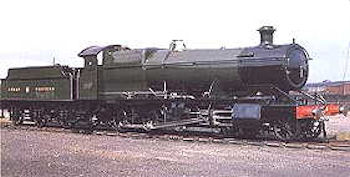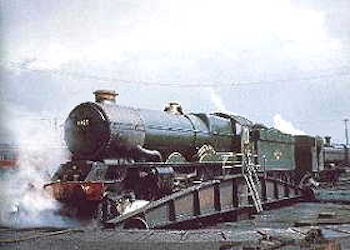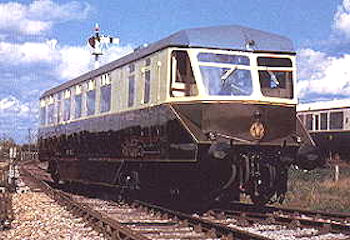
|
|
|
Great Western history, 1892 - 1948
Upon the end of broad gauge use, a wind of change seemed to blow through the entire Great Western network which continued beyond the turn of the century. With the appointment of G. J. Churchward as Locomotive, Carriage and Wagon Superintendent ( a title replaced by Chief Mechanical Engineer in 1916 ), the GWR forged stronger ahead with new ideas, working practices and even new forms of transport connected with the company.
In August 1903, the GWR sponsored the first ever railway owned motor coach service, between Helston and the Lizard in Cornwall. The fleet comprised of five Milnes-Daimler buses, which on hills required the conductor to walk beside the rear wheel with a wooden wedge in case the bus slipped back. As a passenger attraction, the buses were a huge success and within two years the buses had carried nearly a million people by its fleet of by then fifty-eight buses.
In October of that year the GWR introduced an early version of the autotrain service on its Stroud Valley line, while in 1909 the Cunard Line began routing their ships from New York into the refurbished port of Fishguard using the four-funnelled Mauretania, the largest liner afloat.
the largest liner afloat.
Unfortunately for the Great Western, the First World War and the period immediately afterwards brought the biggest amount of change it had seen for a very long time. The GWR and 120 other railway companies throughout the country, were brought under Government control for the duration of the war. Passenger timetables were affected very little for the first two years while freight workings were mostly for the transportation of coal. As the GWR had lines directly to most of the South Wales coalfields, they in total moved 90 per cent of the coal required for the country and nothing was to interfere with these 'Jellicoe Specials' as they were called. As well as serving the ports within the GWR network, the company moved coal to Warrington where the wagons would be picked up by the LNWR and transferred to the North of England or Scottish ports. Throughout the war years, the Navy burnt nearly six million tons of coal in addition to fuel needed by industry. To add to this burden, over 25,000 GWR employees were called up for war duty of which 2,525 would die.
Naturally costs had risen during the war and to offset this the company was forced to increase train fares by 75 per cent with equal rises for goods and mineral traffic. Welsh coal, the essence of the GWR for day to day running, averaged 25 shillings and 10 pence (£1.29) a ton in 1918 against 14 shillings and 4 pence (72p) a ton in 1913 and every minute of the day the Great Western burnt 3½ tons. Wages too were up and the chairman agreed to a bonus of 33 shillings (£1.65) to meet post-war prices. Suddenly these benefits and bonuses were at risk because rumours spread that the Government were to introduce a 40 shillings (£2.00) minimum wage for railwaymen compared to the current 51 shillings (£2.65). The railwaymens response was a sudden strike between the 26 September and 2 October 1919 to which the Government kept the railwaymens pay at its present level.
A far more pressing problem that appeared after the war, was whether the Government would return the railways to their owners or nationalise them. This problem was eventually solved in 1921 by returning the railways to the owners but at the same time, they were ordered to regroup themselves into just four regions, namely the GWR, the LMS, the LNER and the Southern. When the grouping became operative on the 1 January 1923, the GWR gained 560 miles of track, 18000 employees and a further 700 locomotives. The year also brought the restoration of pre-war train speeds and with locomotives hauling a regular 400 tons, a larger engine was required. G. J. Churchward had recently retired and his successor, Charles Benjamin Collett penned the four-cylinder 4-6-0 Castle class of engine. Painted in their full pre-war livery, the crews were to describe them as the equivalent to driving a Rolls-Royce.
The General Strike beginning 3 May 1926 affected every corner of Britain including the Great Western. The strike was called due to disputes between miners and pit owners. Telegrams were sent to each employee of the company reminding them that this dispute was nothing to do with the GWR and stations had posters asking "Whom do you serve?". The strike lasted for just nine days but cost the company over £4 million.
Also in 1926, the GWR realised that although the Castle class of locomotives were very good, they did not answer the problems encountered by the heavy, long-distance, non-stop passenger train. Collett, when drawing up the Castle was restricted by a 20 ton axle loading, but he said that if he was given an axle loading of 22½ tons he would produce a very fine locomotive. This then was the first stages in the concept of the King class and production of the first engine, No. 6000 'King George V', was speeded up for the Baltimore Centenary celebrations.
encountered by the heavy, long-distance, non-stop passenger train. Collett, when drawing up the Castle was restricted by a 20 ton axle loading, but he said that if he was given an axle loading of 22½ tons he would produce a very fine locomotive. This then was the first stages in the concept of the King class and production of the first engine, No. 6000 'King George V', was speeded up for the Baltimore Centenary celebrations.
Although the GWR held its own in a market beset with strikes, rising prices and competition from road hauliers, nothing could have prepared it for the 1930s Depression. Where the company felt hurt the most were the docks of South Wales. The bargain attained in the 1921 Grouping suddenly seemed like a millstone around the GWR's neck. Also in South Wales, the company's mines and ironworks were decimated by the lack of work and the GWR had no alternative but to lay men off. Altogether with these and other manufacturers lay-offs, 36 per cent of the working population of South Wales were made unemployed.
With the cost of coal ever spiralling, the Great Western recognised the significance of diesel fuel and to this the company introduced in February 1934, Britain's first ever diesel rail cars. The original had a single engine of 121 B.H.P. and seating for 69 passengers whereas the later versions formed a twin-set with two 105 B.H.P. engines and seating for 104. Complete with a toilet and buffet, they were to become very popular whether on local branch work or express services between Birmingham and Cardiff.
1935 was to see the Great Western make history by becoming the first British railway to celebrate 100 years of corporate existence. Away from all the glittering festivities, the company was still reeling from its experiences of the Depression. With the King class as its most powerful locomotive, the company seemed content to watch other railways steal a little limelight when introducing faster engines themselves. The Pacific's and A4 Pacific's drawn by Gresley and the Princess Pacific's from Stanier brought faster travel to millions as well as taking the world record for speed by a steam locomotive.
For the GWR, World War II was very different from the First. Instead of coal trains supplying fuel to the navy, the company provided trains for evacuees into the safer West  Country. From Ealing Broadway, the main station for women and children leaving their homes in London, 163 trains carried 112,994 evacuees over just four days. It was quite a new experience for most of the children seeing for the first time green fields with cows and sheep, but the remoteness of their new homes must have troubled some of the youngsters compared to what they were used to.
Country. From Ealing Broadway, the main station for women and children leaving their homes in London, 163 trains carried 112,994 evacuees over just four days. It was quite a new experience for most of the children seeing for the first time green fields with cows and sheep, but the remoteness of their new homes must have troubled some of the youngsters compared to what they were used to.
The winter of 1940-1 brought fears of bombing raids from Germany. Stations that were hit included Bristol, Birmingham, Birkenhead and Plymouth but serious damage also occurred at the South Wales docks especially Swansea. In the winter of 1940 there was also a grave accident at Norton Fitzwarren where a King class locomotive was derailed and 27 passengers lost their lives.
With the end of the war, less than three years remained of independence for Britain's railways, as an all-powerful Labour government had been elected in 1945. Nationalisation had just escaped the GWR in 1921, but now with an immediate programme to full governmental control, the company prepared for the inevitable. When nationalisation took place on the 1 January 1948, the total assets of the Great Western included :
| Capital created | £167,959,878 | ||
| Route mileage | 3,737 miles 15 chains | ||
| Mileage of running lines | 6,577 miles 39 chains | ||
| Total track miles including sidings | 9,244 miles 46 chains | ||
| Number of steam locomotives | 3,857 | ||
| Number of diesel locomotives | 37 | ||
| Number of coaching vehicles | 8,368 | ||
| Number of wagons | 87,403 | ||
| Number of cars and trucks | 2,682 | ||
| Number of horse wagons and carts | 2,357 | ||
| No. of canals - wholly / jointly owned | 10 | ||
| Total length | 208 miles 41 chains | ||
| Docks, harbours and wharves -- | |||
| wholly or jointly owned | 16 | ||
| total length | 164,535 feet | ||
| Steamboats | 9 | ||
| Hotels | 5 | ||
| Houses and cottages | 3,831 | ||
| Staff employed (as at March 29 1947) | 113,601 |
Copyright © by John Daniel 2013.
